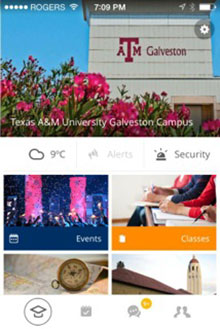Virtual Personal Assistant App Helps Students Manage College Life

Photo: Shutterstock.com
Imagine a mobile app that wakes a student up for his first class, guides him to his classroom via GPS, alerts him to upcoming exams, provides information on study sessions, times his study periods, reminds him that it's his last day to sign up for or drop classes, gives him a profile of students in each of his classes, and automatically inserts classes and events into his smartphone calendar.
Futurist Tech
The 2014 NMC Horizon Report named virtual assistants as a technology that will have a significant impact on higher education in four to five years.
Welcome to the next generation of student apps: the virtual personal assistant; in this case an app with the whimsical name OOHLALA.
While OOHLALA includes most of the standard features of the typical campus app — events, maps, tours, a directory and so forth — it goes beyond being an information access tool. Designed with student engagement in mind, the app allows students to interact with information, pulling classes and events into students' calendars, setting alerts and reminders for class assignments, and even connecting students with peers to form study groups.
Navigating Campus Life
Last year about this time, Ollivier Dyens, deputy provost for McGill University in Montreal, was looking for a campus app and was approached by the OOHLALA team. "We were impressed," said Dyens. "They seemed to be thinking further along." After exploring other options, McGill signed a contract, and the app was delivered in late August, for move-in weekend. "So far, it has been a great experience," Dyens declared. "The app is a virtual personal assistant, fostering better study habits. We saw a lot of potential in it."
With McGill's large student population (about 40,000), the app helps students find their way around a very complex environment. "The complexity creates a lot of stress," said Dyens. "There are often too many things to work through. The app is a way to reduce stress, to find buildings and services, to call for help."

Texas A&M University at Galveston's OOHLALA app
At the other end of the population spectrum is Texas A&M University at Galveston, with its marine-based curriculum and 2,300 students. "We launched the app last June, and the students jumped right on it. We were surprised by how much students have taken it on," said Shelly Fordyce, director of student activities. She added that students show up for new classes already knowing each other: "They're making plans, finding roommates, connecting to the university."
"We liked the way this app brought the academic and non-academic together," said Joe Hoff, associate director for recreational sports, "especially for new students. These students struggle with time management, going from having a very strict schedule in high school to the more fluid college environment, with few classes, a host of extra-curricular activities and a lot of personal freedom."
In addition, Fordyce noted, the application's reporting functions provide "quite a bit of information," such as trends and student conversations, much of which is posted on a Facebook-like "Wall." The analytics tool allows administrators to parse through vast data sets of student conversations and automatically rank them as being positive or negative. These indicators can point to times when students may be stressed out or depressed, giving the institution the ability to provide early intervention support.
Notable
The founders of OOHLALA made Forbes' "2015 30 Under 30: Education" list this month for their work in innovating higher education.
Engaging Students
"We're focusing on delivering a personalized experience for students," according to Danial Jameel, OOHLALA co-founder and CEO. When you really "dig down" to the challenges of students, he explained, one resource is consistently constrained: time. "We're asking — how do students organize their academic, campus and social lives? How do we provide a personalized experience for them? And, finally, how can institutions better understand student behavior?"
Jameel continued, "We live in a world bombarded with distractions and complexities. We feel strongly that technology should provide value; that it shouldn't increase complexity; that it should simplify. It should help you only when you need it and then disappear. Technology should do the dirty work so students can focus on the important things."
About the Author
Toni Fuhrman is a writer and creative consultant based in Los Angeles.